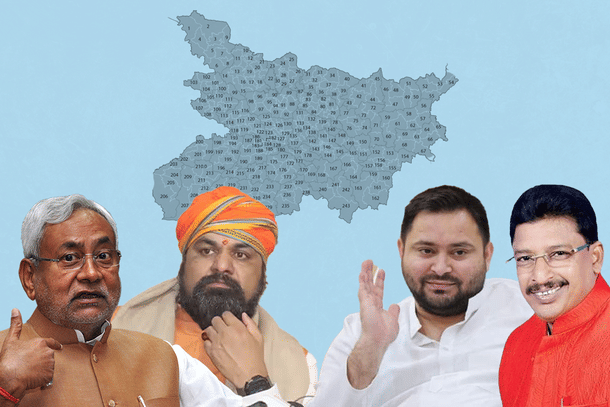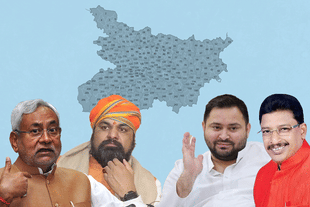Politics
Bihar: As Tejashwi Yadav Looks Beyond M-Y, 'Luv-Kush' Become His First Target
Abhishek Kumar
Jun 25, 2024, 03:27 PM | Updated 04:08 PM IST
Save & read from anywhere!
Bookmark stories for easy access on any device or the Swarajya app.


In an unprecedented move, Rashtriya Janata Dal (RJD) has appointed Abhay Kumar Kushwaha as head of the parliamentary committee of the party. Kushwaha is a newly elected Member of Parliament (MP) from Aurangabad Lok Sabha constituency.
The decision came as a surprise since Misa Bharti, Lalu Yadav's daughter and MP from Patliputra, was believed to be frontrunner.
The appointment is largely seen as part of Tejashwi Yadav’s efforts to reimagine RJD’s political math in Bihar. RJD is traditionally known for its emphasis on Muslim and Yadav (M-Y) voters. Problem with depending on the M-Y formulation (which RJD's cousin, the Samajwadi Party also banks on in Uttar Pradesh), is the combination can yield only 30-32 per cent votes in Bihar, that too assuming that no vote drifts apart.
To deal with this handicap, Tejashwi Yadav, in February this year, coined a new phrase that represents the new electoral math for the party — M-Y-BAAP. The acronym BAAP used by Tejashwi refers to 'Bahujan', 'Agada' (forward), 'Aadhi Aabadi' (women) and Poor.
Kushwahas and Koeris are the first set of communities outside the fold of M-Y to be actively pursued by Tejashwi Yadav as part of the outreach to make this new electoral math work on the ground. Kushwahas are mainly Kurmis. Kurmis share a brotherhood bond with Koeris (also known as Luv-Kush duo in Bihar politics). For many, Koeris and Kurmis are two sides of the same coin.
According to a caste survey conducted by the Bihar government, Koeri-Kurmi collectively have a 7.09 per cent share in Bihar's population. This places them at the third largest population group after Muslims (17.7 per cent) and Yadavs (14.26 per cent). Within the framework of Other Backward Classes (OBCs), they are second behind Yadavs.
Traditionally, they have been supportive of Nitish Kumar, who himself belongs to the Kurmi community. With few ups and downs, Upendra Kushwaha’s association with Janata Dal (United) or JD(U) has also helped the party garner these votes. For Bharatiya Janata Party (BJP), Samrat Choudhary is its biggest Koeri face, a big part of the reason behind him becoming state president of the party and deputy chief minister of state.
Given the weight that the community has in Bihar's politics, it had become a necessity for Tejashwi Yadav to give preferential treatment to 'Luv-Kush'.
In the 2024 general elections, Indian National Developmental Inclusive (INDI) Alliance, gave 20 per cent of its tickets to the Luv-Kush duo in the state. The distribution of tickets was overseen almost single-handedly by Tejashwi Yadav himself.
The move seems to have worked. Apart from Abhay Kumar Kushwaha from Aurangabad, Raja Ram Singh of Communist Party of India (Marxist-Leninist) (Liberation) also registered victory from Karakat. In fact, in Karakat, Upendra Kushwaha, a tall leader of the community, despite support from National Democratic Alliance, had to taste defeat.
However, Tejashwi took a calculated risk with this move, assuming that the RJD's base — Muslims and Yadavs — do not have other options.
However, results prove his assumption to be only partially correct. Against its calculated figure of 38 per cent (M-Y and Kushwahas), RJD got only 22 per cent votes. Even if we add up vote share of its alliance partners, it does not add up to Tejashwi Yadav's liking.
Apparently, either the NDA has penetrated the M-Y vote block to some extent or both groups are looking at other options.
There is a clear disenchantment among Muslim voters against RJD regarding ignoring the community in ticket distribution. On ground, Muslim votes went to RJD more because of Rahul Gandhi than Tejashwi Yadav.
For Yadavs, the discontentment arises from the fact that apart from Lalu Yadav’s family members, very few Yadav leaders gain traction in the party. They are specially miffed with the way Tejashwi Yadav tried to throttle Pappu Yadav’s ascendancy in Purnia.
RJD's new electoral math will now be put to test in the 2025 assembly elections in the state.
Abhishek is Staff Writer at Swarajya.





